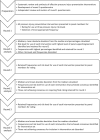International consensus on pressure injury preventative interventions by risk level for critically ill patients: A modified Delphi study
- PMID: 33591631
- PMCID: PMC7948917
- DOI: 10.1111/iwj.13461
International consensus on pressure injury preventative interventions by risk level for critically ill patients: A modified Delphi study
Abstract
The aim of this modified Delphi study was to determine a minimum pressure injury preventative intervention set for implementation relative to critically ill patients' risk level. Preventative interventions were identified via systematic review, risk levels categorised by an intensive-care-specific risk-assessment-scale (COMHON Index), and panel members (n = 67) identified through an international critical care nursing body. Round 1: panel members were asked to rate implementation of 12 interventions according to risk level (low, moderate, high). Round 2: interventions were rated for use at the risk level which received greatest round 1 support. Round 3: interventions not yet achieving consensus were again rated, and discarded where consensus was not reached. Consensus indicated all patients should receive: risk assessment within 2-hours of admission; 8-hourly risk reassessment; and use of disposable incontinence pads. Additionally, moderate- and high-risk patients should receive: a reactive mattress support surface and a heel off-loading device. High-risk patients should also receive: nutritional supplements if eating orally; preventative dressings (sacral, heel, trochanteric); an active mattress support surface; and a pressure-redistributing cushion for sitting. Repositioning is required at least 4-hourly for low-risk, and 2-hourly for moderate- and high-risk patients. Rigorous application of the intervention set has the potential to decrease pressure injuries in intensive care.
Keywords: critical care; intensive care unit; patient care bundles; pressure injury; pressure ulcer.
© 2020 Medicalhelplines.com Inc (3M) and John Wiley & Sons Ltd.
Conflict of interest statement
We declare there are no known conflicts of interest associated with this manuscript and there has been no financial support for this work that could have influenced its outcome.
Comment in
-
Comment on "International consensus on pressure injury preventative interventions by risk level for critically ill patients: A modified Delphi study".Int Wound J. 2021 Oct;18(5):742-743. doi: 10.1111/iwj.13520. Epub 2020 Nov 9. Int Wound J. 2021. PMID: 33169540 Free PMC article. No abstract available.
Similar articles
-
Comment on "International consensus on pressure injury preventative interventions by risk level for critically ill patients: A modified Delphi study".Int Wound J. 2021 Oct;18(5):742-743. doi: 10.1111/iwj.13520. Epub 2020 Nov 9. Int Wound J. 2021. PMID: 33169540 Free PMC article. No abstract available.
-
Pressure ulcer prevention: an evidence-based analysis.Ont Health Technol Assess Ser. 2009;9(2):1-104. Epub 2009 Apr 1. Ont Health Technol Assess Ser. 2009. PMID: 23074524 Free PMC article.
-
Pressure ulcer incidence and progression in critically ill subjects: influence of low air loss mattress versus a powered air pressure redistribution mattress.J Wound Ostomy Continence Nurs. 2012 May-Jun;39(3):267-73. doi: 10.1097/WON.0b013e3182514c50. J Wound Ostomy Continence Nurs. 2012. PMID: 22552108
-
Consensus Recommendations for Blood Culture Use in Critically Ill Children Using a Modified Delphi Approach.Pediatr Crit Care Med. 2021 Sep 1;22(9):774-784. doi: 10.1097/PCC.0000000000002749. Pediatr Crit Care Med. 2021. PMID: 33899804 Free PMC article. Review.
-
Core outcome measures for clinical effectiveness trials of nutritional and metabolic interventions in critical illness: an international modified Delphi consensus study evaluation (CONCISE).Crit Care. 2022 Aug 6;26(1):240. doi: 10.1186/s13054-022-04113-x. Crit Care. 2022. PMID: 35933433 Free PMC article.
Cited by
-
Comment on "International consensus on pressure injury preventative interventions by risk level for critically ill patients: A modified Delphi study".Int Wound J. 2021 Oct;18(5):742-743. doi: 10.1111/iwj.13520. Epub 2020 Nov 9. Int Wound J. 2021. PMID: 33169540 Free PMC article. No abstract available.
-
Compliance with preventive measures recommended by an international study group for pressure injuries in adult critically ill patients.Int Wound J. 2023 Apr;20(4):1205-1211. doi: 10.1111/iwj.13979. Epub 2022 Oct 21. Int Wound J. 2023. PMID: 36270634 Free PMC article.
-
Translation and piloting of the Chinese Mandarin version of an intensive care-specific pressure injury risk assessment tool (the COMHON Index).Int J Nurs Sci. 2022 Mar 18;9(2):169-178. doi: 10.1016/j.ijnss.2022.03.003. eCollection 2022 Apr. Int J Nurs Sci. 2022. PMID: 35509692 Free PMC article.
-
Use of a risk-based intervention bundle to prescribe and implement interventions to prevent pressure injury: An observational study.J Adv Nurs. 2025 Sep;81(9):5315-5328. doi: 10.1111/jan.16309. Epub 2024 Jul 5. J Adv Nurs. 2025. PMID: 38969344 Free PMC article.
-
Authors' response to comment on "International consensus on pressure injury preventative interventions by risk level for critically ill patients: A modified Delphi study".Int Wound J. 2021 Oct;18(5):738-741. doi: 10.1111/iwj.13519. Epub 2020 Nov 16. Int Wound J. 2021. PMID: 33200527 Free PMC article. No abstract available.
References
-
- Black JM, Edsberg LE, Baharestani MM, et al. Pressure ulcers: avoidable or unavoidable? Results of the National Pressure Ulcer Advisory Panel consensus conference. Ostomy Wound Manage. 2011;57(2):24‐37. - PubMed
-
- Schmitt S, Andries MK, Ashmore PM, Brunette G, Judge K, Bonham PA. WOCN Society Position Paper: Avoidable versus unavoidable pressure ulcers/injuries. J Wound Ostomy Continence Nurs. 2017;44(5):458‐468. - PubMed
-
- Li Z, Lin F, Thalib L, Chaboyer W. Global prevalence and incidence of pressure injuries in hospitalised adult patients: a systematic review and meta‐analysis. Int J Nurs Stud. 2020;105:103546. - PubMed
-
- Jackson D, Durrant L, Bishop E, et al. Pain associated with pressure injury: a qualitative study of community‐based, home‐dwelling individuals. J Adv Nurs. 2017;73(12):3061‐3069. - PubMed
MeSH terms
Grants and funding
LinkOut - more resources
Full Text Sources
Medical


